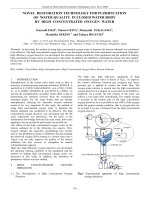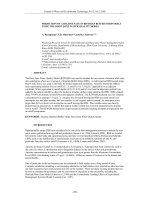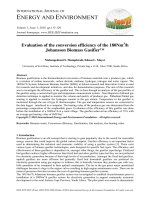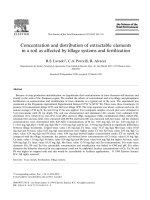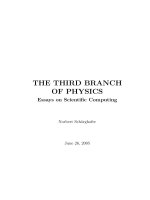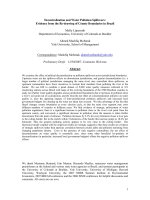INCREASING THE WORKING EFFICIENCY OF ABRASIVE GRAINS IN MACHINING SKD11 STEEL BY USING NEWLY DEVELOPED INCLINED SEGMENTED GRINDING WHEEL
Bạn đang xem bản rút gọn của tài liệu. Xem và tải ngay bản đầy đủ của tài liệu tại đây (555.48 KB, 5 trang )
HỘI NGHỊ KHCN TOÀN QUỐC VỀ CƠ KHÍ - ĐỘNG LỰC NĂM 2017
Ngày 14 tháng 10 năm 2017 tại Trường ĐH Bách Khoa - ĐHQG TP HCM
INCREASING THE WORKING EFFICIENCY OF ABRASIVE GRAINS IN
MACHINING SKD11 STEEL BY USING NEWLY DEVELOPED
INCLINED SEGMENTED GRINDING WHEEL
Tien Dong Nguyen*
Hanoi University of Science and Technology, No. 1, Dai Co Viet, Hai Ba Trung, Hanoi, Viet Nam
ABSTRACT:
In this paper, newly developed inclined
segmented grinding wheel (ISGW), which have
segments on the working surface; angle between
these segments and a shaft of grinding machine
β=15º, were used to grind SKD11 steel which is
popular material in mold making technology. The
percentage of discontinue on wheel surface
symbolized by η, is defined as the ratio between
the area does not containing abrasive grains and
the total area of wheel surface. Four ISGWs, with
different percentage of discontinue η (16.37,
18.19, 20.01 and 21.83%) and a conventional
wheel with η = 0% were used in experimental
process. The number of abrasive grain in contact
with sample surface per unit area per second ,
was calculated to evaluate the efficiency of
abrasive grains by wheel rotation speed, feeding
speed and percentage of discontinue η. Surface
roughness
of ground sample was employed.
When the number of abrasive grain
increase or
the feeding speed S decrease, the surface
roughness
of surface ground by conventional
grinding wheel decrease, but it obtained the same
values by using ISGWs. It seems that the surface
roughness does not depend on number of
abrasive grain participate in the grinding process.
In other word, the working efficiency of abrasive
grains can increase up to 20% as increasing of
the feeding speed from 12 m/min to 15 m/mm
using inclined segmented grinding wheels.
Keywords: inclined segmented grinding wheel (ISGW), SDK11 steel, roughness, abrasive grains .
1. INTRODUCTION
In the last few years, grinding process is a
strategic process for machining new materials
with tough characteristics, such as hard and brittle
materials, ceramics, etc, which required a good
accuracy and a high quality of surface roughness.
Grinding process can be used to combine high
removal rate with high accuracy [1]. Alternatively,
grinding can be employed with moderate removal
rates to produce high accuracy parts in large
volumes. In manufacturing mold plate, spherical
grinding plays an important role because it is the
simplest and least expensive process for
machining materials which is popular in mold
making technology. To increase the productivity
and quality of grinding process, researchers not
only spend time to optimize the parameters on
machine, apply new materials but also present
new design of wheels to reduce average force
and temperature to have better surface
roughness, such as cup-type diamond-grindingwheels with hexagonal pattern were used to grind
ceramic material shows advantage of increasing
effective working abrasive grains in comparison
with conventional grinding wheels [2]. According
to the previous researches, smoother surface can
be obtained by decreasing speed rate or
decreasing cutting depth [3-14], but speed rate or
cutting depth have the limit depending on ground
samples or grinding machines.
In this work, newly developed inclined
segmented grinding wheels - ISGW with different
number of segments on the wheel surface are
used to grind SKD11 steel, which is applied
widely in manufacturing mold plate and base. The
effects of abrasive grains and surface roughness
of ground sample are evaluated. This paper
reveals a new mechanism of grinding process by
the proposed ISGWs.
Trang 145
HỘI NGHỊ KHCN TOÀN QUỐC VỀ CƠ KHÍ - ĐỘNG LỰC NĂM 2017
Ngày 14 tháng 10 năm 2017 tại Trường ĐH Bách Khoa - ĐHQG TP HCM
2. EXPERIMENTAL
Newly
developed
grinding wheel
inclined
segmented
experiment, grinding wheels were dressed by
industrial diamond grinding stone with grinding
conditions of 0.1 mm cutting depth, 450 rpm
wheel rotation speed in order to obtain flatness on
the wheel surface.
Figure 1. Inclined segmented grinding wheel
which has outside diameter D = 350 mm, inner
diameter d = 127 mm, wide of segment
w = 10 mm, height of segment h = 15 mm,
thickness B = 40 mm and inclined angle β=15
These wheels are characterized by number
of segment Z, and inclined angle of segment
β=15º. All the wheels have outside diameter of
350 mm, inner diameter of 127 mm, wide and
height of segment are 10 mm and 15 mm
respectively. Percentage of discontinue η, is
defined as the ratio between the area does not
containing abrasive grains and the total area of
wheels. Four inclined segmented grinding wheels
with different η (16.37, 18.19, 20.01 and 21.83%)
and a conventional wheel with η = 0% were used
as shown in Table 1.
Figure 2. Grinding machine AMADA WASINO
SE63
Figure 3. Surface roughness Mitutoyo SJ-301
Table 1. Number of segment Z and % discontinue
η of grinding wheels
Z
η
Z=0
Z = 18
Z = 20
Z = 22
Z = 24
0%
16,37%
18,19%
20,01%
21,83%
Experiment procedures
Samples are SKD11 steel with dimensions of
Length x Wide x Height = 60x30x10 mm. A
sample was placed at the center of machine table
so that long edge was perpendicular to the shaft
of machine. Conventional and inclined segmented
grinding wheels (Cn46 MV2 350x40x127-35m/s)
were
used.
Before
each
Trang 146
Grinding wheel rotation speed 450 rpm for
the whole experiment process. On each grinding
wheel, experiment was carried out on 3 different
cutting conditions with cutting depth was 0.02 mm
per pass, feeding speed were 12, 15 and 20
m/min alternatively. The wheels were redressed
before each grinding experiment. The coolant
water was sprayed into the contact zone between
grinding wheel and sample during grinding
process. Grinding conditions are listed in Table 2.
The surface roughness,
was measured using
roughness tester Mitutoyo SJ-301.
HỘI NGHỊ KHCN TOÀN QUỐC VỀ CƠ KHÍ - ĐỘNG LỰC NĂM 2017
Ngày 14 tháng 10 năm 2017 tại Trường ĐH Bách Khoa - ĐHQG TP HCM
Table 2. Specifications of grinding wheels,
grinding conditions and sample
Grinding wheels
Inner
diameter:
127 mm
Outside diameter:
350 mm
Thickness: 40mm
Segment wide: 10
mm
Segment height:
15 mm
Inclined angle: 15º
Cn:
Corundum
abrasive
46:
Size
of
abrasive grain
MV2: Hardness
Grinding
condition
Rotation
speed: 450
rpm
Cutting
depth:
0.02mm and
0.05mm
Feeding
speed:
12,
15 and 20
m/min
Sample
Material:
SKD11
Length:
60mm
Wide:
30mm
Height:
10mm
3. RESUTS AND DISCUSSION
Figure 4 and 5 show surface roughness Ra
as function of number of segment Z for different
feeding speed S = 12 and S = 15 m/min
respectively. The same trend of the surface
roughness on sample ground by ISGW with 2
different feeding speeds can be observe.
Discussion
With small change in number of segment Z,
depth of cut a or feeding speed S. It is difficult to
recognize the differences of input parameter
between different cutting conditions. Number of
abrasive grain participate in grinding process is
possible choice in this situation.
Figure 6. Peripheral surface of conventional
grinding wheel
Number of abrasive grain in contact with
sample surface per unit area per second on
conventional grinding wheel:
∙
=
(grain)
(1)
Where
grinding wheel revolution to
complete the grinding process along the length of
workpiece in the experiment;
is a number of
abrasive on working surface of grinding wheel, in
the conventional wheel used in the experiment
= 109900 grains.
Figure 4. Sample surface roughness Ra as
function of number of segment Z at S = 12 m/min,
a = 0.02 mm on SKD11
= 12 m/min = 200 mm/s
Time need to complete the grinding process along
the length of workpiece:
= =
= 0.3 (s)
(2)
Grinding wheel revolution to complete the grinding
process along the length of workpiece:
∙ V = 0.3 ∙ 24.17 = 7.251 (rev)
=
(3)
Number of abrasive grain in contact with sample
surface per unit area per second by conventional
grinding wheel:
=
Figure 5. Sample surface roughness Ra as
function of number of segment Z at S = 15 m/min,
a = 0.02 mm on SKD11
∙
=
∙
= 332
(grains)
(4)
= 15 m/min = 250 mm/s
Time need to complete the grinding process along
the length of workpiece:
Trang 147
HỘI NGHỊ KHCN TOÀN QUỐC VỀ CƠ KHÍ - ĐỘNG LỰC NĂM 2017
Ngày 14 tháng 10 năm 2017 tại Trường ĐH Bách Khoa - ĐHQG TP HCM
= =
= 0.24 (s)
(5)
Grinding wheel revolution to complete the grinding
process along the length of workpiece:
=
(6)
∙ V = 0.24 ∙ 24.17 = 5.801 (rev)
Number of abrasive grain in contact with sample
surface per unit area per second by
conventional grinding wheel:
∙
=
= 5.801 ∙
= 266
(grains) (7)
The number of abrasive grain in contact with
sample surface per unit area per second on ISGW
can be calculated due to percentage of
discontinue η on table 1.
Table 3. Number of abrasive grain in contact with
sample surface per unit area per second on each
grinding wheels at S = 12 m/min and S = 15
m/min
TT
Z
%
discontinu
eη
Number of
abrasive
grain
1
Z=0
0
332
266
2
Z = 18
16,37%
278
222
3
Z = 20
18,19%
272
218
4
Z = 22
20,01%
266
213
5
Z = 24
21,83%
260
208
Figure 7, illustrate the relation between
number of abrasive grain in contact with surface
sample per unit area per second XS and surface
roughness Ra. On conventional grinding wheel,
the surface roughness Ra decrease when the
number of abrasive grain in contact with sample
surface per unit area per second
increase or
the feeding speed S decrease. This result is in
accord with metal cutting theory, which has been
published in many researches about grinding
operation, there are clear differences in surface
roughness among different number of abrasive
grain [4-6]. However, on ISGW, the desired
surface roughness can be achieved at the cutting
conditions with less number of abrasive grain. To
put it differently, on ISGW, surface roughness
does not depend on number of abrasive grain
participate in the grinding process.
As shown in Figure 8, Curve (I) for feeding
speed S = 12 m/min and Curve (II) for feeding
speed S = 15 m/min in figure 7. By multiplying
0.75 to the value of
for the feeding speed S =
12 m/min, Curve (I) of feeding speed S = 12
m/min superposes on Curve (II) for feeding speed
S = 15 m/min as shown in Figure 9. In other
words, working efficiency of abrasive grain on
ISGW can increase by 25% by increasing the
feeding speed from 12 m/min to 15 m/min.
Figure 8. Surface roughness,
versus number
of abrasive grains XS. Curve (I) for feeding speed
S = 12 m/min and Curve (II) for feeding speed S =
15 m/min
Figure 7. Number of abrasive grain in contact
with sample surface per unit area per second as
function of surface roughness Ra at a=0.02m/min
Trang 148
HỘI NGHỊ KHCN TOÀN QUỐC VỀ CƠ KHÍ - ĐỘNG LỰC NĂM 2017
Ngày 14 tháng 10 năm 2017 tại Trường ĐH Bách Khoa - ĐHQG TP HCM
Figure 9. Surface roughness, Ra versus number
of abrasive grains XS. Curve (I) of feeding speed
S = 12 m/min is superposed on Curve (II) of
feeding speed S = 15 m/min by multiplying 0.75 to
the value of XS of feeding speed S = 12 m/min
[3]
S. Malkin, Grinding Technology Theory and
Applications Machining with Abrasives,
Chichester, England: Ellis Horwood Limited
Publication, 1989.
[4]
M. C. Shaw, Principles of
Processing,
USA:
Oxford
Publications, 1996.
[5]
J. E. Mayer and G. P. Fang, "Effects of
Grinding Parameters on Surface Finishing of
Ground Ceramics", Annals of the CIRP, vol.
44, 1995.
[6]
G. Warnecke and U. Rosenberger, "Basic of
Process Parameter Selection in Grinding of
Advanced Ceramics", Annals of the CIRP,
vol. 44, 1995.
[7]
J. Pe´rez, S. Hoyas, D.L. Skuratov, Yu.L.
Ratis, I.A. Selezneva, P. Ferna´ndez de
Co´rdoba, J.F. Urchueguı´a eHeat “Transfer
analysis of intermittent grinding processes”,
International Journal of Heat and Mass
Transfer 51 (2008) 4132–4138.
[8]
Taghi Tawakoli, Bahman Azarhoushang*
(2011) “Intermittent grinding of ceramic
matrix composites (CMCS) utilizing a
developed segmented whell”.
[9]
Xiarui Fan, Michele Miller, Force analysis for
segmental grinding, chining Science and
Technology, 10 (2006), 435-455.
4. CONCLUSIONS
In this work, samples made by SKD11 steel
are ground by a conventional and newly
developed ISGWs. The abrasive grain efficiency
and surface roughness were evaluated. The
following can be concluded:
Surface roughness of sample ground by
conventional wheel decrease as the
number of abrasive grain
increase.
On ISGWs, surface roughness obtained
the same values when feeding speed S
are changed from 12 m/min to 15 m/mm
alternately. In other words, surface
roughness does not depend on number of
abrasive grain participate in the grinding
process.
It is possible to increase the working
efficiency of abrasive grain on ISGW by
25% by increasing the feeding speed
from 12m/min to 15m/min.
REFERENCES
[1]
W. B. Rowe, Principles of Modern Grinding
Technology, Massachusetts: Elsevier, 2013.
[2]
Tien Dong NGUYEN, Koji MATSUMARU,
Masakazu TAKATSU and Kozo ISHIZAKI,
"Abrasive Grain Efficiency And Surface
Roughness For Machining Ceramics By
Newly developed Cup-Type DiamondGrindings-Wheels,"
Advantage
in
Technology of Material and Material
Processing, vol. 10, pp. 77-84, 2008.
Abrasive
Science
[10] Agarwal S, Venkateswara Rao P, “A new
surface roughness prediction model for
ceramic grinding”, Proc Inst Mech Eng, B J
Eng Manuf, 219 (11) (2005) 811–821.
[11] Young HT, Liao HT, Huang HY, “Surface
integrity of silicon wafers in ultra precision
machining”, Int J Adv Manuf Technol,
29(3–4) (2006) 372–378.
[12] W. H. Tuan, J. C. Kuo, “Effects of grinding
parameters on the reliability of alumina”,
Materials Chemistry and Physics, 52 (1998)
41-45.
[13] R. Gupta, K. S. Shishodia, G.S. Sekhon,
“Optimization of grinding process parameters
using enumeration method”, Journal of
Material Processing Technology, 112 (2001)
63-67.
[14] G. F. Li, L. S. Wang, L. B. Yang, “Multi-
parameter optimization and control of the
cylindrical grinding process”, Journal of
Material Processing Technology, 129 (2002)
232-236.
Trang 149
